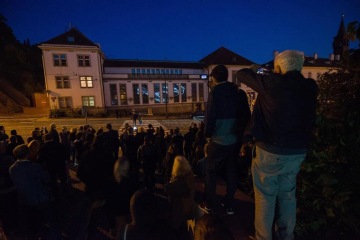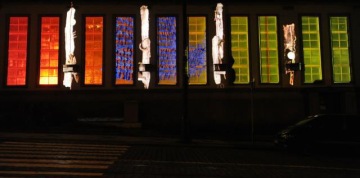Transformace - Pešánek / Díaz
The project TransFormace reveals to its audience a remarkable story: in the year 1930 the visionairy artist Zdeněk Pešánek designed kinetic sculptures One Hundred Years of Electricity for the facade of the newly built substattion. The sculptures were, however, never installed on the building and unfortunatally they survived only in the form of models housed by the National Gallery in Prague. After almost 100 years, the contemporary artist Federico Díaz created a legacy to this story.
Today, artists of tomorrow draw on paper what we should see hovering in space or what should be projected on the sky.
F. Kalivoda, 1941 Excerpt from the preface to “Kinetismus”, a book by Zdeněk Pešánek
A visionary, that's what a creator whose thoughts were ahead of technologies of his time is a posteriori called. Zdeněk Pešánek surely belongs to this category of artists. His light-kinetic sculptures designed for the public space in the 20s and 30s of the previous century were created only at a cost of a complex, tedious and never totally satisfying work. Though to make his multimedia assemblies, Zdeněk Pešánek was using the most innovative elements and materials of the time: celluloid, light bulbs and neons.These imperfect tools were not translucent enough to diffuse light properly, and were too fragile to withstand adverse weather conditions and their life span was therefore limited. Moreover, acoustic reproduction techniques were still in their infancy and didn't allow for permanent addition of sound to objects or its synchronization with movement and light. It's therefore no surprise that none of Pešánek's original light-kinetic sculptures has been preserved in public space until today.
The series of sculptures entitled One Hundred Years of Electricity didn't escape this fate either. It is Pešánek's most ambitious multimedia project from the inter-war period which was initially destined for the facade of Zenger electrical substation. The series of didactic character.was created as a commission for Prague Electric Company. It depicts recent history of electricity from 1836 (death of physicist André-Marie Ampère) till 1936 (end of works onthe electrical substation). Each of the four sculptures from the One Hundred Years of Electricity cycle symbolizes one key phase from this period. These light-kinetic assemblies composed of eclecticindustrial as well as organic elements illustrate the following topics: Ampère's law, electric motor principle, transformer principle, growth of electricity production.
Fotografie © Jan Rasch a © ČTK/Deml Ondřej
One Hundred Years of Electricity was first exhibited at the Museum of Decorative Arts in Prague in 1936, and in the following year it was included in the Czechoslovak presentation at the International Exhibition of arts and technology in Paris, where it enjoyed great success. The four sculptures mysteriously disappeared after they returned from the Paris exhibition to Prague too damaged to be installed outdoors. The only traces of this project visible on Zenger electrical substation are the four plinths nicely aligned on its facade which have remained absurdly empty since the very first day.
Before launching the renovation of the Zenger electrical substation building, Kunsthalle Praha wanted to return the sculptures to their place topay tribute to Zdeněk Pešánek. In fact, this visionary artist embodies the building's industrial past as well as its future cultural function. Zdeněk Pešánek as an authorof atypical, hybrid and timeless works of art represents an emblematic reference for a space dedicated to artistic creativity in all its diversity.To revive One Hundred Years of Electricity we turned to one of the most talented of Pešánek's successors: Czech-Argentinian artist Federico Díaz. Federico Díaz is a prominent figure on the contemporary scene and what he shares with the avant-garde artist is an insatiable curiosity for new technologies. And like Pešánek, Díaz places his artistic practice at the intersection of several disciplines: sculpture, architecture, music, and science. His works integrate the notions of space and temporality and explore the relation between nature and technology.
© Monoskop.org
-
Zdeněk Pešánek – Electric motor principle, 1932.
-
Zdeněk Pešánek – Ampère's law, 1932.
-
Zdeněk Pešánek – Growth of electricity production in Prague 1880–1936, 1936.
-
Zdeněk Pešánek - Transformer principle, 1932.
The work Transformace Pešánek-Díaz was a result of this commission given to Federico Díaz. It was presented on September 30th 2017 on the occasion of the Day of Architecture in Prague as the first site-specific project produced for Kunsthalle Praha. It's not an identical reproduction of the Hundred Years of Electricity series, but a video installation freely inspired by Pešánek`s vision. Federico Díaz applied digital creative tools, a 3D scan and an animation program, while working with rare available archival documents and four models preserved in the National Gallery in Prague. Thanks to these new technologies, and mostly thanks to Díaz's talent, Pešánek's work, liberated from the constrains of time and space, has become immaterial, ephemeral as well as potentially eternal. The modular, animated, color, sonorous sculptures are projected on a facade or on a different surface, appearing and disappearing at will. This work of art is stored as a digital file that can be reproduced an infinite number of times. It's an ultra contemporary form of art prefigured almost a century ago!
Text:Christelle Havranek






